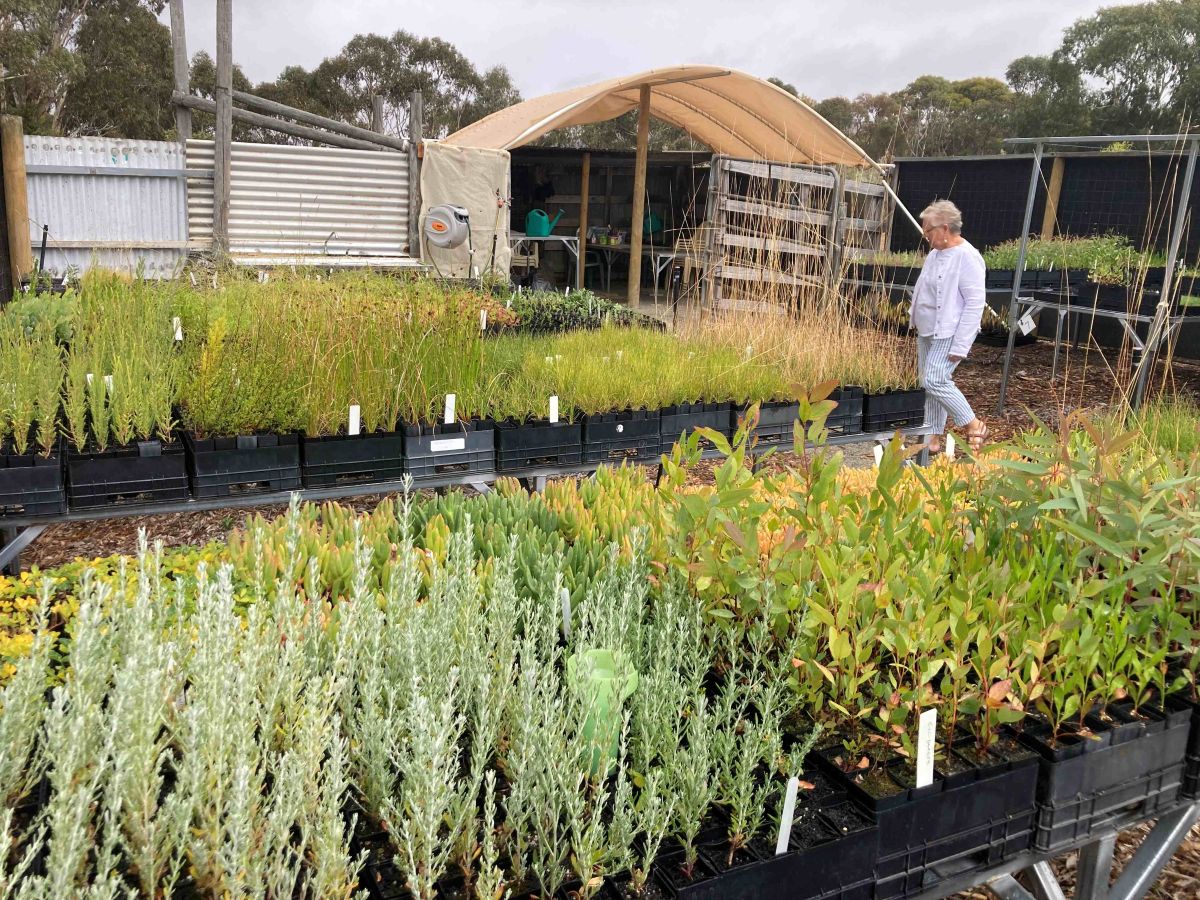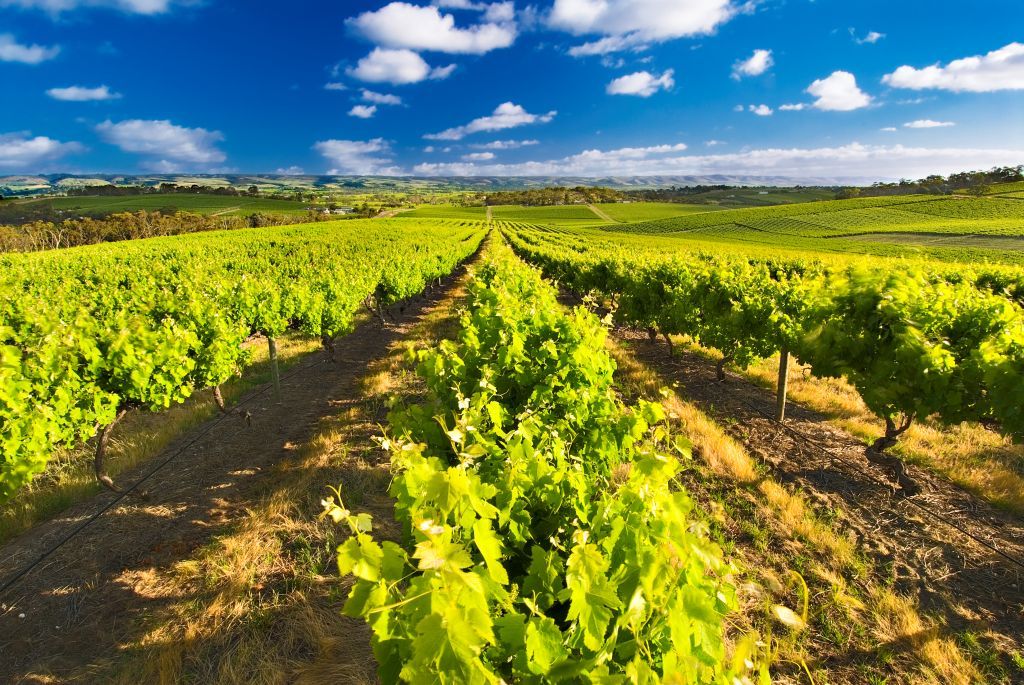The Fleurieu adapts to a dry future
FA Contributor
20 November 2025, 11:46 PM
 Pop UP Nursery with native seedling capacity. Photo credit: Biodiversity Victor Harbor
Pop UP Nursery with native seedling capacity. Photo credit: Biodiversity Victor HarborWords: Tahney Fosdike
Thanks to Coast Lines magazine
This work has been kindly supported through Local & Independent News Association's (LINA) environmental reporting fund grant.
South Australia is the driest state on the driest inhabited continent, and the Fleurieu Peninsula is one of its most arid corners. With declining rainfall, rising temperatures and increasingly frequent droughts, the region is taking collective responsibility to be water wise and future ready.
Over the past few years, residents of the Fleurieu Peninsula have experienced unpredictable weather and are grappling with its ongoing effects. For avid birdwatcher Mark Richards, who has lived on the south coast for almost 25 years, the signs are everywhere.
“When I walk in environmental areas to find birds, it’s obvious what’s happening,” he says. “Large native plants and gum trees are stressed from lack of water.”
In 2022, above-average rainfall helped revegetate bushfire-hit areas. But since then, conditions have been harsher. Last year the Fleurieu recorded its driest 12-month period on record, with Strathalbyn receiving just 68% of its usual rainfall. This year the region hasn’t seen much improvement; the Bureau of Meteorology reported that southern and central South Australia received the lowest 30% of all September rainfall since 1900.
Richards points to trending data that shows temperatures are increasing, with places across Australia breaking October records of over 46 degrees at the beginning of spring. The fallout goes beyond the human community; trees and shrubs are dying, freshwater fish are stranded, and native spiders, butterflies and bees are at risk of extinction.
“As the temperature increases, we will see fauna and flora migrate south to try and find cooler climates with it,” he adds, “During this recent drought, rural property owners were inundated with kangaroos trying to find feed and water.”
But drought isn’t just low rainfall. According to the Adelaide Hills and Fleurieu Kangaroo Island Regional Drought Resilience Plan, drought is an abnormally dry period that affects connections between people, industry and ecosystems. When one is stressed, the others feel the strain. Strengthening each part of this system is key to building resilience for the entire region.

Pop UP Nursery with native seedling capacity - Photo provided.
Water in a dry landscape
On the Fleurieu, water primarily comes from surface sources—rain captured in tanks, dams and reservoirs, as well as groundwater from bores.
This year, many tanks and springs have run dry with some areas, such as up to 80% of the Yankalilla area, not connected to mains water. Local water-carting services have been stretched, with some communities waiting weeks for deliveries and sometimes running out of water for drinking, washing and sanitation in the meantime.
To meet demand, a new bulk water collection point opened in McLaren Vale in March. According to an SA Water spokesperson, the Myponga Reservoir still holds 17 billion litres of water in its multi-year storage, designed to withstand both wet and dry years.
Nevertheless, recent low rainfall and shortages have led the region to rethink allocation, diversify supply and adopt innovative strategies for managing water in a changing climate.
“It’s a limited resource in our region,” says viticulturist Giulio Dimasi from D'Arenberg winery, explaining that the main water challenges for winegrowers are accessibility, cost and reliance on recycled water.
The McLaren Vale winery is proud to have the capacity to store 1.4 million litres of rainwater alongside bore water and participate in the Willunga Basin Water recycled effluent system, with all their non-effluent water on site captured and treated for irrigation.
The drought has also prompted investment in technology, with D'Arenberg adopting an online irrigation management system that monitors and records water usage in real-time.
“Efficient irrigation is the most effective strategy at this stage,” Dimasi says, “The ability to control our irrigation online is a strong addition to the industry.”

D'Arenberg's vineyard - Photo provided.
Biodiversity in action
As vineyards like D'Arenberg innovate and respond to scarce water, their efforts are mirrored in collective climate action and biodiversity recovery projects gaining momentum across the Fleurieu.
The region is one of Australia’s fifteen biodiversity hotspots, home to more than 850 natural wetlands. These ecosystems purify and store water, cool landscapes and provide habitat and refuge for plants and wildlife, especially during dry periods. Farmers are protecting these landscapes through the Fleurieu Swamp Restoration Network, a group of 50 landholders that is restoring over 100 hectares of wetlands to improve water security and wildlife habitat in the face of future droughts.
Likewise, The Forktree Project, a charity founded in 2019, is restoring a pastoral property with native trees and shrubs to bring back native animals, insects and birds while sequestering tens of thousands of tonnes of carbon.
“The drought has been challenging for us, like for many in the Hills and the Fleurieu,” says Forktree’s environmental scientist Tim Jarvis AM. With only a third of the usual annual rainfall, they carefully planned to cope with the drier weather.
They dug small bowls around each plant to capture morning dew, fog and rain, and relied entirely on rainwater capture in their nursery. Rainwater on every roof, stock dams and a reuse scheme for overspray all help them stretch scarce water.
They also grew the Fleurieu Swamp Restoration Network’s biodiverse plants for this season, showing the power of community collaboration.
Biodiversity Victor Harbor (a community not-for-profit charity), where Mark Richards is the Chairperson, is also tackling environmental challenges through action and advocacy.
“People are concerned and want to do things,” he says, “The difficulty is that they have limited time and or don't understand what opportunities there are.”
By removing membership fees, they encourage participation, using newsletters and events to connect members with petitions, plantings and other initiatives. Over the past two years, the organisation has attracted ecologists, journalists, solicitors and their patron Professor Hugh Possingham, whom Richards describes as, “South Australia’s answer to David Attenborough,” and, “also an avid bird watcher.”
Together, they connect with government and environmental foundations to promote sustainable practices, such as biodiversity-friendly farming methods with economic benefits, while also urging councils to improve their environmental resource allocation.
After starting a small pop-up nursery, with a community planting of 7,500 seedlings, they secured council support for a large-scale biodiversity nursery. With a capacity for 50,000 seedlings annually, it will propagate native species, research those suitable for future climates, and supply Indigenous plants to the community.
It will be a place, Richards says, to test questions like, “Do you propagate and plant current species that are pre-European, or do you start finding species of flora that are used to high levels of temperature because that's what the future might look like?
“It will also raise awareness of the right plants to purchase – often not available in major retailers – that are more drought resilient, with these purchasable on the website,” he says.

Tim at Forktree - photo provided.
Leadership and drought preparedness
As drought intensifies, leaders are under pressure to develop resilient infrastructure and safeguard the social, environmental and economic well-being of their communities.
“Grassroots environmental groups doing magnificent work,” says Richards, “But to be effective, local councils need to focus on allocating resources and talking to and helping rural communities so they're economically viable, resilient, and adaptable to changes.”
He adds that councillors often face competing priorities, but more investment in the environment is needed, whether for water-saving activities, recycled water, or planting Indigenous species.
There is some action; last November the South Australian Government announced an $18 million drought relief package. Additionally, under the new National Drought Agreement (2024–2029), all Australian governments are now prioritising proactive measures to build resilience and mitigate the impact of drought before it occurs.
David Basham MP, Member for Finniss and Shadow Minister for Environment and Water Infrastructure, stresses that plans should be transparent, collaborative and long-term, with decisions grounded in science, new technologies, industry realities and community resilience. They should also engage everyone from irrigators, councils and industry, to environmental experts.
“When governments make decisions on allocations, it cannot be in isolation,” he says.
“I believe in striking the right balance. We need to protect local jobs and economies when considering water efficiency projects. We must never lose sight of the fact that water is the lifeblood of our industries, our farms and our regional communities.”
City of Onkaparinga Mayor Moira Were is also concerned with water availability as climate change collides with rapid population and urban growth, increasing demand for potable water and water-sensitive infrastructure.
The council’s Climate Change Response Plan 2022–27 focuses on water supply and education, including the Sustainable Onkaparinga program, which provides workshops, online resources and practical water-saving tips for residents and businesses. A draft McLaren Vale Water Security Strategy also addresses tensions around regional water demands and seasonal irrigation.
The Mayor highlights a recycled water network, created during the Millennium Drought, that delivers 200 megalitres of recycled water to parks, sports grounds and schools via a 53-kilometre pipeline and acts as a safeguard during restrictions.
“We face water challenges on a number of fronts, and tackle these in a number of ways,” she says.
She encourages locals to make every drop count by capturing rainwater and greywater, using council rebates, grants and resources like Homes for Tomorrow, and creating homes that are both sustainable and cost-efficient.
Steps for homes and farms
Beyond government and conservationist initiatives, residents and farmers play a critical role in adapting to scarcity. Communities should recognise that water is a shared and finite resource and diversify their sources, rather than relying solely on short-term emergency responses, such as water carting.
Tim Jarvis suggests recycling water from sinks, showers and washing machines using a capture system, such as placing a bucket under the shower while waiting for hot water, to water plants or flush the toilet. SA Water suggests capturing and reusing water—such as treated wastewater or stormwater—for irrigation, gardens, or industrial uses to reduce demand on personal drinking supplies.
“We always encourage our customers to use water in a smart and effective manner,” says an SA Water spokesperson. “Simple measures, such as watering your garden in the early morning or late evening to minimise evaporation and fixing dripping taps, can help reduce daily water usage.
“Minor tweaks to how we use water, especially in the garden, can have a real impact on overall usage and make a valuable contribution to preserving our water sources.”
On domestic properties, Richards and Jarvis advise planting native plants near buildings, as well as native grasses and shrubs, which require less water, reduce fire risk and provide food and shelter for native birds and insects. For farms, they recommend planting deep-rooted native grasses and belts of native trees and shrubs in paddocks. These practices conserve water, provide a resilient feed source for livestock, shelter them from the heat, maintain soil moisture and produce longer-lasting pasture.
While Richards emphasises the need for, “a rethink about how agriculture is done,” with drought resilience depending on farms adopting regenerative and biodynamic practices, he stresses combining these with education on financial benefits to reduce market fears.
Likewise, David Basham highlights modernising farm infrastructure by upgrading irrigation channels, adopting on-farm systems and producing with less water. Equally, he believes that government initiatives should not unfairly burden regional farmers and primary producers with water recovery.
Building drought resilience
“Rural communities are made up of resilient, practical people, but last summer certainly tested us all,” Jarvis says.
On the Fleurieu, drought is now not a question of if or when but an event that will come again and again. With the region projected to experience nearly twice as long droughts by 2030, building resilience is essential.
Residents, farmers, businesses and local leaders must proactively work together to protect this unique and beautiful landscape, safeguard its water and wildlife and support Fleurieu people and industries well into the future.